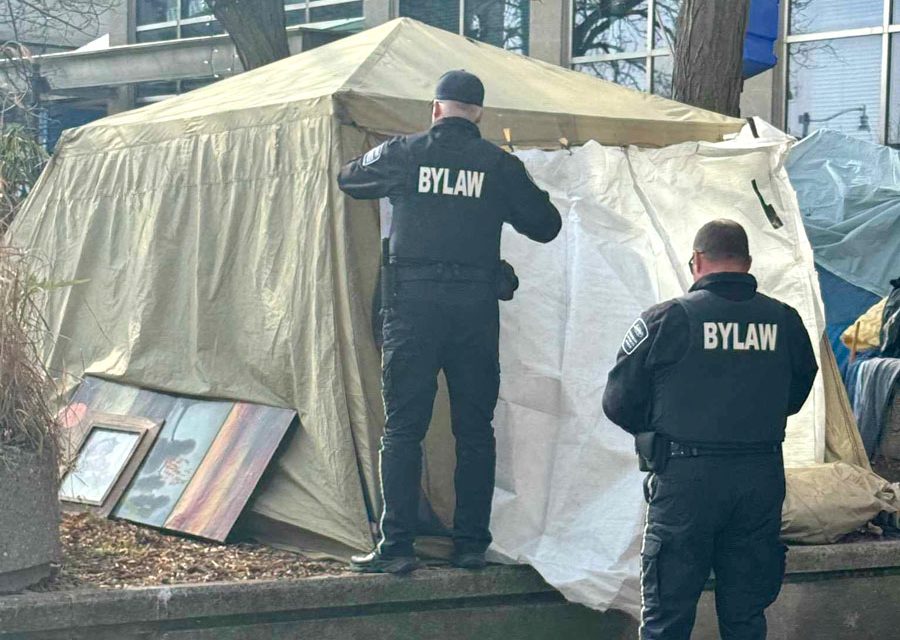GUELPH – With an eviction deadline staring them in the face, unhoused people living in downtown Guelph’s St. George’s Square don’t know what they are going to do come Nov. 13.
Guelph city council recently passed a public space use bylaw that restricts where encampments can be located.
St. George’s Square is identified as a “sensitive public space” not suitable for encampments and on Oct. 30, bylaw officers taped notices to the 20-some shelters in the square.
Those in the encampment have until Nov. 13 to remove their tents, shelters and belongings.
Until about a week ago, Jason Mazza was among them. He lived in the square for about nine months after a series of events led to him being homeless.
He recently secured housing though, and was in the square on Nov. 1 to check on his friends and donate some of the clothing he doesn’t think he’ll be needing.
“The encampment is a great community of people,” he said. “It’s the ‘walk-bys’ (people who walk by and stare) that are more of the issue. They go out of their way to take pictures and make unneeded comments.
“We have a right to be housed.”
Mazza said he had a job and an apartment and things were good until he was in a car accident that was life altering.
He was in hospital for months, lost his job and his housing, and because of an issue with the Ministry of Transportation, it appears on paper that he still owns some cars. That means he has assets, according to Ontario Works, and he doesn’t qualify for funding.
Although he has a place to stay now, “I have no guaranteed income,” he said. He’ll still be living hand-to-mouth.
“The stress level is even more,” he said, now that he has more to lose.
Guelph’s deputy CAO of public services Colleen Clack-Bush stated in an email the posted notices refer to the shelters and structures that must be removed, “and not the individuals themselves,” she said.
There are many public services offered in the downtown core, from social services to the safe injection site, to health care and mental health services, to food and clothing offered by local churches.
People will still be allowed to congregate and be downtown. They just can’t erect structures for sleeping.
“Following Nov. 13, city staff will proceed with the dismantling of shelters that haven’t yet been removed,” Clack-Bush said.
She acknowledged an increased presence of bylaw officers in the core, “to monitor and provide support as needed for those who are complying with the order to remove their structures,” she said.

This infographic is what the City of Guelph is using to explain its new public space use bylaw. Encampments are permitted; just not within the restricted areas. Image from Guelph website
Guelph Police also announced in a press release on Oct. 28 a public safety initiative targeted at open drug use and “associated criminal behaviour” downtown.
On Nov. 1 at around 4pm, there were two bylaw vehicles parked on Wyndham Street and two Guelph Police vehicles parked around the corner in the BMO parking lot.
Police and bylaw officers stood together by the fountain in the square observing the scene and talking amongst themselves.
They were just there and not approaching people, but the thin blue line is intimidating, Mazza said.
He called the police community safety initiative the “heat program.
“We’re living in a police state,” he said.
Mazza added pushing the homeless population to the fringes of public parks, which are allowed for encampments according to the bylaw, removes them from the services offered downtown and the community they have formed in the core.
“They are moving (the homeless) so they don’t see them, stuffing them in the woods,” Mazza said.
“It makes access to programs even harder instead of looking at the root cause.”
The city had provided a map of places in Guelph where encampments are allowed but has since removed it from its website.
“In an effort to provide the most accurate and clear information possible, we have removed the Public Space Use bylaw map from the website at this time. Instead, we’ve provided an infographic to help people understand the specifics of the bylaw more clearly,” Clack-Bush said.
“The map was initially created as a visual demonstration tool and was not intended as a complete representation of the bylaw or part of the bylaw itself.”
She said the map caused confusion; the public space use bylaw is the official resource.
The infographic doesn’t say where encampments can be located – only that five tents per cluster are permitted and there must be 10 meters of separation between clusters.
There’s a long list of where they can’t go, such as playgrounds; splash pads, including Market Square; on paths or trails; in fountains, including St. George’s Square; or within 10 metres of schools and playgrounds or lakes and rivers.
Clack-Bush said bylaw officials will work with police on enforcement matters when needed and bylaw officers will visit new encampment locations to ensure people are safe.
With not much hope in sight, many of those residing in St. George’s Square did not want to speak to a reporter.
Instead they turned their backs to the wind, rolled up their collars and hunkered down for one more night in the square.




